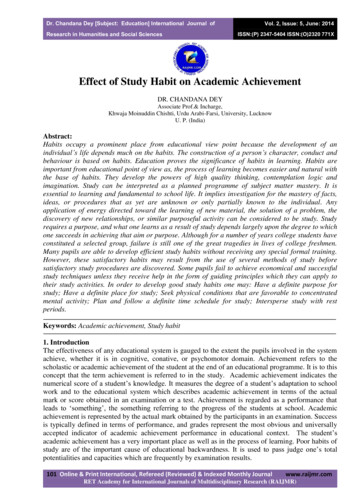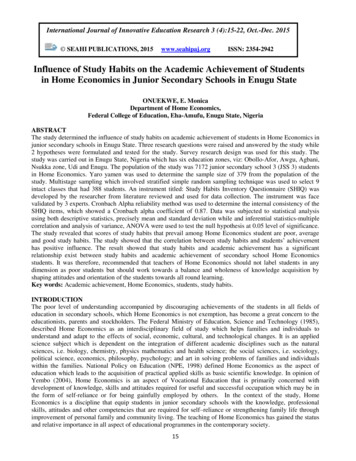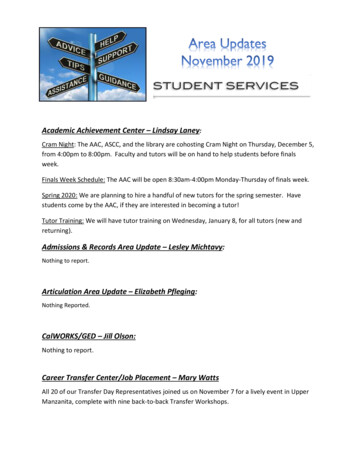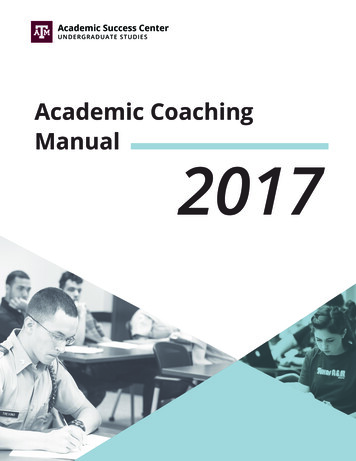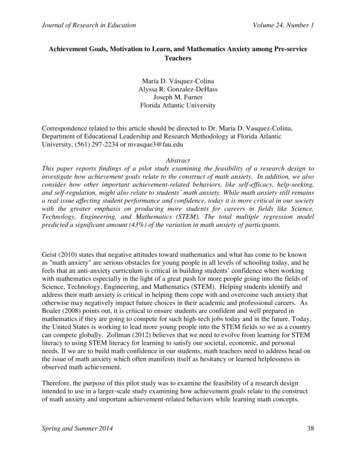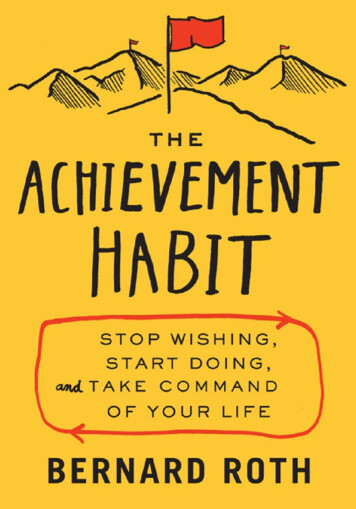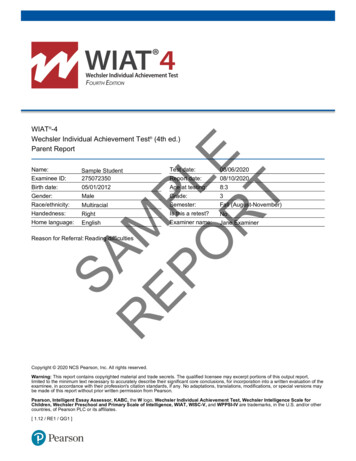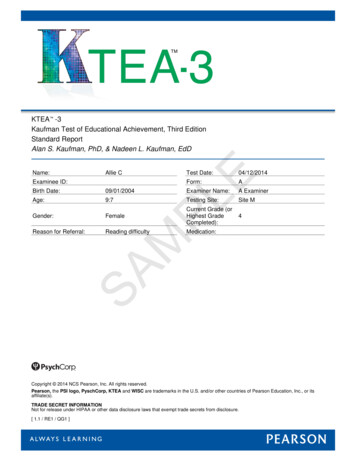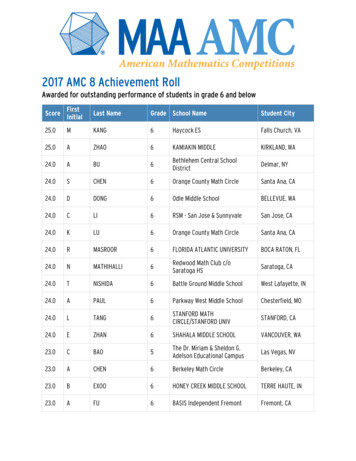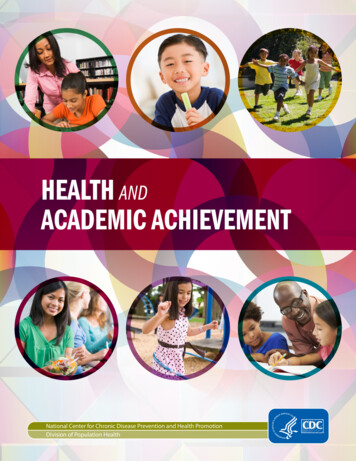
Transcription
HEALTH ANDACADEMIC ACHIEVEMENTNational Center for Chronic Disease Prevention and Health PromotionDivision of Population Health
Healthy Kids. Successful Students. Stronger Communities.Schools, health agencies, parents, and communities share a commongoal of supporting the link between healthy eating, physical activity,and improved academic achievement of children and adolescents.Evidence shows that the health of students is linked to theiracademic achievement, so by working together, we can ensure thatyoung people are healthy and ready to learn.1-4 Public health andeducation professionals can use this resource to share the linkbetween healthy eating, physical activity, and improved academicachievement to engage stakeholders in working together to supporthealthy school environments. This resource includes1.Evidence linking healthy eating and physical activity withacademic achievement.2.Evidence-driven messages with specific benefits to states,school districts, schools, parents, and students.3.Specific, feasible, and effective actions to support healthyeating and physical activity in schools.4.Key resources to learn more.Academic AchievementFor this document, we defineacademic achievement as21. Academic performance(class grades,standardized tests, andgraduation rates).2. Education behavior(attendance, dropoutrates, and behavioralproblemsat schools).3. Students’ cognitiveskills and attitudes(concentration, memory,and mood).Know the EvidenceKnowing the evidence is important to help make the case for addressing healthy eating and physicalactivity in schools. There are several possible direct and indirect pathways linking healthy eating andphysical activity with academic achievement in schools. While the current evidence is limited butevolving, it shows that certain factors in a school environment can positively influence the health ofstudents and improve academic achievement. These factors include access to healthy foods andopportunities to stay physically active.4 Improving access to healthy foods and physical activities islinked to healthier students who are also better learners.2,3How to use the research: The evidence can be used in presentations, key documents, or anyother resource that communicates the evidence link between health (i.e., healthy eating andphysical activity) and academic achievement.Evidence on dietary behaviors and academic achievement2 Student participation in the United States Department of Agriculture (USDA) School BreakfastProgram (SBP) is associated with increased academic grades and standardized test scores,reduced absenteeism, and improved cognitive performance (e.g., memory).3, 5–11 Skipping breakfast is associated with decreased cognitive performance (e.g., alertness, attention,memory, processing of complex visual display, problem solving) among students.8, 9, 11–17 Lack of adequate consumption of specific foods, such as fruits, vegetables, or dairy products, isassociated with lower grades among students.18–20CENTERS FOR DISEASE CONTROL AND PREVENTION
Deficits of specific nutrients (i.e., vitamins A, B6, B12, C, folate, iron, zinc, and calcium) areassociated with lower grades and higher rates of absenteeism and tardiness among students.4, 5, 10 Hunger due to insufficient food intake is associated with lower grades, higher rates ofabsenteeism, repeating a grade, and an inability to focus among students.5, 10, 19–23Evidence on physical activity and academic achievement Students who are physically active tend to have better grades, school attendance, cognitiveperformance (e.g., memory), and classroom behaviors (e.g., on-task behavior).24–30 Higher physical activity and physical fitness levels are associated with improved cognitiveperformance (e.g., concentration, memory) among students.30–35 More participation in physical education class has been associated with better grades,standardized test scores, and classroom behavior (e.g., on-task behavior) among students.36–39 Increased time spent for physical education does not negatively affect students’ academicachievement.2, 32 Time spent in recess has been shown to positively affect students’ cognitive performance (e.g.,attention, concentration) and classroom behaviors (e.g., not misbehaving).40–44 Brief classroom physical activity breaks (i.e., 5-10 minutes) are associated with improvedcognitive performance (e.g., attention, concentration), classroom behavior (e.g., on-taskbehavior), and educational outcomes (e.g., standardized test scores, reading literacy scores,math fluency scores) among students.28, 45–50 Participation in extracurricular physical activities such as interscholastic sports has beenassociated with higher grade point averages (GPAs), lower drop-out rates, and fewer disciplinaryproblems among students.51–63Share the MessageAll stakeholders, including parents, educators, and public health professionals, can use the evidenceto support messages about the importance of healthy eating and physical activity and their link toacademic achievement. Using consistent messages creates better understanding and awareness ofthe need for addressing healthy eating and physical activity in schools. Core messages are provided thatapply to all audiences and connect with common values and beliefs of multiple stakeholders. In additionto the core messages, audience-specific messages are provided that identify the unique benefits for fivekey audiences.How to use the messages: The core and audience-specific messages can be used in conversation,PowerPoints, Webinars, meetings, presentations, Web content, e-mails, newsletters, and otherprint documents.HEALTH AND ACADEMIC ACHIEVEMENT3
Core MessagesThe core messages articulate the importance of increased access to healthy foods andphysical activities in schools as ways to enhance the academic achievement of students.How to use core messages: Use messages when communicating with different audiences at both the state and local level (e.g.,parents, schools, teachers, administrators, public health professionals). Incorporate at least 1–2 core messages in all communication to support both healthy eating andphysical activity strategies in schools (conversation, PowerPoints, Webinars, meetings, presentations,Web content, e-mails, newsletters, print documents).Core Messages:1. Healthy students are better learners Healthy students are better on all levels of academic achievement: academic performance,education behavior, and cognitive skills and attitudes.2. Schools can influence eating and physical activity behaviors Students spend much of their time at school, and may eat as many as 2 out of 3 meals per dayand may get much of their physical activity at school.3. Healthy, successful students help build strong communities Investing in the health of students contributes to healthy communities in the future.4. All students deserve the opportunity to be healthy and successful 4Providing access to healthy foods and physical activity plays an important role in the academicachievement of students.CENTERS FOR DISEASE CONTROL AND PREVENTION
Audience-Specific MessagesThe audience-specific messages reflect the benefits of addressing healthy eatingand physical activity in schools for each stakeholder audience.How to use audience messages: Add these messages to the core messages when communicating to specific stakeholder audiencesin all communication (conversation, PowerPoints, Webinars, meetings, presentations, Web content,e-mails, newsletters, print documents). Use messages to support both healthy eating and physical activity strategies in schools.AudienceBenefitStates (publichealth andeducationagencies) Focusing on healthy eating and physical activity in schools can help reduce barriersto learning. Healthy students are more likely to have higher levels of education.SchoolDistricts Investing in healthy school nutrition environments and school physical activity programscan play an important role in school reform. Helping students stay healthy through eating healthy foods and being physically activecan help school districts achieve better overall test scores, grades, and attendancerates. Promoting healthy eating and physical activity can help schools meet theireducational goals. Implementing strategies that help students stay healthy through eating healthy foodsand being physically active can result in decreased rates of student absenteeism, fewerbehavioral problems, and higher school-wide test scores and grades. Schools can create a healthy learning environment and provide opportunities for yourchild to practice healthy behaviors. Helping your child’s school support healthy eating and physical activity can help thembecome better learners, healthier adults, and ready for college. Learning about healthy eating and physical activity in school will give you the knowledgeand skills to make good health decisions now and in the future. Eating healthy and staying active in school can help you feel better, do better in sports,concentrate, and get better grades and test scores.SchoolsParentsStudentsHEALTH AND ACADEMIC ACHIEVEMENT5
Take ActionCreating healthy schools requires action from different stakeholders. Use the evidence and messagesto engage stakeholders to take action to help make schools a place for health and learning. The tablebelow identifies possible actions different audiences can take. The actions below are not comprehensivebut rather identify a sample of key actions to support schools in adequately addressing healthy eatingand physical activity to improve academic th andeducationagencies) Create partnerships between departments of health and education and other keystakeholders to help support the connection among healthy eating, physical activity, andacademic achievement. Provide consistent messages about the connection among healthy eating, physicalactivity, and academic achievement that school districts and schools can use to getsupport for addressing health in schools. Develop policies that support healthy school nutrition environments (e.g., access tohealthy and appealing foods and beverages; consistent messages about food and healthyeating; opportunities for students to learn about healthy eating). Develop policies that support a comprehensive approach to physical activity in schools(e.g., quality physical education programs, physical activity before and after school likea walking and biking to school programs); physical activity during school (e.g., recess,physical activity breaks in and outside the classroom); school employee wellnessprograms); and parent and community engagement. Provide professional development and technical assistance to school districts andschools on healthy school nutrition environments and a comprehensive approach tophysical activity in schools. Seek funding opportunities to support new activities and incentives for schools to createhealthy school environments. Create partnerships between the local departments of health and education and otherkey stakeholders to help support the connection among healthy eating, physical activity,and academic achievement. Establish, implement, and evaluate local school wellness policies that supporthealthy school nutrition environments and a comprehensive approach to physical activityin schools. Provide professional development to schools on healthy food options for breakfast andlunch, standards for competitive foods (e.g., school store, vending machines), and atschool-sponsored events. Provide professional development to schools on a comprehensive approach to physicalactivity in schools (e.g., quality physical education programs, walking and biking to schoolprogram, recess, physical activity breaks in and outside the classroom). Collect data on health and educational behaviors and outcomes to assess the benefitsof school health (e.g., healthy eating, physical activity) policies and practices.SchoolDistricts6CENTERS FOR DISEASE CONTROL AND PREVENTION
AudienceActionSchools Establish a school health advisory council or wellness committee that includes schoolstaff, parents, students, and other community members and that meets regularly todevelop and implement a school-wide plan for addressing healthy eating and physicalactivity in schools. Develop policies that support healthy school nutrition environments and a comprehensiveapproach to physical activity in schools. Provide professional development to school staff on the importance of healthy eating andphysical activity and their connection to learning. Provide healthy food options for breakfast and lunch, in other school venues (e.g., schoolstore, vending machines), and at school-sponsored events. Provide physical education programs, recess for elementary students, classroom-basedphysical activity, and extracurricular physical activities (e.g., sports programs, physicalactivity club). Support health education programs to incorporate topics on nutrition and physicalactivity. Include school health as an important element in school improvement plans. Support parent and community engagement in school health activities. Incorporate health into recognition programs and school metrics and accountability. Be involved in school health activities at your child’s school—this can be done byattending classes on health topics supported by the school, communicating with theschool about health issues, volunteering to support health activities, making decisionsrelated to school health policies and practices, and reinforcing health messages taught inschool at home. Help your school put into action the local school wellness policy that focuses on nutritioneducation, foods and beverages sold at school, physical activity, and physical education. Ask the school to provide educational opportunities for you to learn about the connectionbetween health and academic achievement and the importance of healthy eating andphysical activity. Talk to other parents about ways they can help support and promote healthy schoolnutrition environments and a comprehensive approach to physical activity in schools. Join a group that supports and can address a healthy school environment such as theParent Teacher Association (PTA), school health advisory council, school wellness council,and school improvement team. Participate on state, district, or school health advisory councils or other health-relatedcommittees. Learn why it is important to eat healthy and stay active and share it with your classmates. Lead activities in your school that promote eating healthy and being physically active. Ask your classmates what information and activities they would like to have at the schoolrelated to healthy school nutrition environments and physical activity andphysical education. Share ideas from your classmates with school staff and talk about helping to meet theneeds of students.ParentsStudentsHEALTH AND ACADEMIC ACHIEVEMENT7
Use the ResourcesBelow are resources to learn more about how healthy eating and physical activity can play a role inimproving the academic achievement of students. The resources are from the federal governmentand national organizations. Some of the resources provide specific data, while others review existingevidence and give practical suggestions and recommendations for states, school districts, and schoolsin supporting healthy eating and physical activity to enhance academic achievement.Breakfast for Learning. Food Research and ActionCenter, 2011.This is a research brief developed by the Food Researchand Action Center that highlights the link betweeneating breakfast and learning.Health in Mind, Healthy Schools Campaign, 2012.This report is from Healthy Schools Campaign (HSC) andTrust for America’s Health (TFAH) and details immediatesolutions that can help close the achievement gap andcreate a healthy future for all children. Health in Mindfocuses on several federal initiatives and policies thatcan broadly benefit the health, well-being and educationof the nation’s students.Healthier Students Are Better Learners: A Missing Linkin Efforts to Close the Achievement Gap. ColumbiaUniversity, 2010.This report articulates that educationally relevanthealth disparities, such as how participation in andaccess to physical activity and eating breakfast improveeducational opportunities and outcomes of students.Student Health and Academic Achievement. Centers forDisease Control and Prevention, 2009.These are fact sheets developed buy the Centers forDisease Control and Prevention show the link betweenhealth behaviors (e.g., physical inactivity, unhealthydietary behaviors) and academic grades.The Association Between School-Based PhysicalActivity, Including Physical Education, and AcademicPerformance. Centers for Disease Control andPrevention, 2010.This report examined how different physical activitycontexts in schools, including physical education,recess, classroom-based activity, and extracurricularactivities are associated with a variety of academicoutcomes.The Healthy School Communities Model: AligningHealth & Education in the School Setting. Associationfor Supervision of Curriculum Development, 2011.This document describes the actions that schools andschool communities need to take to make systemicchange that improves the health, well-being, growth, anddevelopment of their students, staff, and schools.The Learning Connection: What You Need to Know toEnsure Your Kids Are Healthy and Ready to Learn,Action for Healthy Kids, 2013.This report developed by Action for Healthy Kids is aroadmap for parents, educators, school administratorsand school volunteers to create healthier schoolenvironments so the kids in their lives are betterpositioned to learn.The Wellness Impact: Enhancing Academic AchievementThrough Healthy School Environments, GENYOUTH,2013.The report, produced by National Dairy Council, inpartnership with GENYOUth Foundation, AmericanCollege of Sports Medicine, and American SchoolHealth Association, highlights that improved nutritionand physical activity can help lead to better academicperformance. This report serves as a launch pad toignite the conversation about how all sectors of societycan work together to create an atmosphere wherechildren have the knowledge, options, and opportunitiesto help them reach their full potential.Web M8CENTERS FOR DISEASE CONTROL AND PREVENTION
References1.McKenzie, FD, Richmond, JB. Linking health and learning:An overview of coordinated school health programs. In:Marx E, Wooley SF, Northrop D, eds. Health is Academic: AGuide to Coordinated School Health Programs. New York,NY: Teachers College Press; 1998.2.Centers for Disease Control and Prevention. TheAssociation Between School-based Physical Activity,Including Physical Education, and Academic Performance.Atlanta, GA: U.S. Department of Health and HumanServices; 2010.3.4.5.6.7.Bradley, B, Green, AC. Do Health and EducationAgencies in the United States Share Responsibility forAcademic Achievement and Health? A Review of 25years of Evidence About the Relationship of Adolescents’Academic Achievement and Health Behaviors, Journal ofAdolescent Health. 2013; 52(5):523–532.Basch CE. Healthier Students Are Better Learners: AMissing Link in Efforts to Close the Achievement Gap.New York: New York. Columbia University; 2010. uityMattersVol6 Web03082010.pdf. Accessed February26, 2014.Kleinman RE, Hall S, Green H, Korzec-Ramirez D, PattonK, Pagano, ME, Murphy JM. Diet, breakfast, and academicperformance in children. Annals of Nutrition & Metabolism.2002;46(suppl 1):24–30.Meyers AF, Sampson AE, Weitzman M, Rogers BL,Kayne H. School breakfast program and schoolperformance. American Journal of Diseases of Children.1989;143(10):1234–1239.Murphy JM, Pagano ME, Nachmani J, Sperling P, KaneS, Kleinman RE. The relationship of school breakfast topsychosocial and academic functioning: Cross-sectionaland longitudinal observations in an inner-city schoolsample. Archives of Pediatrics and Adolescent Medicine.1998;152(9):899–907.8.Pollitt E, Mathews R. Breakfast and cognition: anintegrative summary. American Journal of ClinicalNutrition. 1998; 67(4), 804S–813S.9.Rampersaud GC, Pereira MA, Girard BL, Adams J,Metzl JD. Breakfast habits, nutritional status, bodyweight, and academic performance in children andadolescents. Journal of the American Dietetic Association.2005;105(5):743–760, quiz 761–762.10. Taras, H. Nutrition and student performance at school.Journal of School Health. 2005;75(6):199–213.11. Murphy JM. Breakfast and learning: an updated review.Current Nutrition & Food Science. 2007; 3:3–36.12. Benton D, Jarvis M. The role of breakfast and amidmorning snack on the ability of children toconcentrate at school. Physiology & Behavior. 2007;90(2–3):382–385.13. Gajre NS, Fernandez S, Balakrishna N, Vazir S. Breakfasteating habit and its influence on attention concentration,immediate memory and school achievement. IndianPediatrics. 2008;45(10):824–828.14. Wesnes KA, Pincock C, Richardson D, Helm G, and HailsS. Breakfast reduces declines in attention and memoryover the morning in schoolchildren. Appetite. 2003;41(3):329–331.15. Vaisman N, Voet, H, Akivis A, Vakil E. Effect of breakfasttiming on the cognitive functions of elementary schoolstudents. Archives of Pediatrics & Adolescent Medicine.1996;150(10):1089–1092.16. Widenhorn-Müller K, Hille K, Klenk J, Weiland U. Influenceof having breakfast on cognitive performance and moodin 13- to 20-year-old high school students: results of acrossover trial. Pediatrics. 2008;122(2):279–284.17. Mahoney CR, Taylor HA, Kanarek RB, Samuel P. Effectof breakfast composition on cognitive processes inelementary school children. Physiology & Behavior. 2005;85(5): 635–645.18. MacLellan D, Taylor J, Wood K. Food intake and academicperformance among adolescents. Canadian Journal ofDietetic Practice and Research. 2008;69(3):141–144.19. Neumark-Sztainer D, Story M, Dixon LB, Resnick MD,Blum RW. Correlates of inadequate consumption ofdairy products among adolescents. Journal of NutritionEducation. 1997;29(1):12–20.20. Neumark-Sztainer D, Story M, Resnick MD, BlumRW. Correlates of inadequate fruit and vegetableconsumption among adolescents. Preventive Medicine.1996;25(5):497–505.21. Alaimo K, Olson CM, Frongillo EA. Food insufficiency andAmerican school-aged children’s cognitive, academic, andpsychosocial development. Pediatrics. 2001;108(1):44–53.22. Kleinman RE, Murphy JM, Little M, Pagano M, WehlerCA, Regal K. Hunger in children in the United States:potential behavioral and emotional correlates. Pediatrics.1998;101(1):E3.23. Pollitt E, Cueto S, Jacoby E. Fasting and cognition inwell- and undernourished schoolchildren: a review ofthree experimental studies. American Journal of ClinicalNutrition. 1998;67:779S–784S.24. Centers for Disease Control and Prevention. StudentHealth and Academic Achievement Web site. http://www.cdc.gov/healthyyouth/health and academics/index.htm.Accessed February 28, 2014.25. Budde H, Voelcker-Rehage C, Pietrayk-Kendziorra S,Ribeiro P, Tidow G. Acute coordinative exercise improvesattentional performance in adolescents. NeuroscienceLetters. 2008;441(2):219–223.HEALTH AND ACADEMIC ACHIEVEMENT9
26. Dwyer T, Blizzard L, Dean K. Physical activity andperformance in children. Nutrition Reviews. 1996;54(4 Pt 2):S27–S31.27. Tuckman BW, Hinkle JS. An experimental study of thephysical and psychological effects of aerobic exercise onschoolchildren. Health Psychology. 1986;5(3):197–207.40. Barros RM, Silver EJ, Stein RE. School recess and groupclassroom behavior. Pediatrics. 2009;123(2):431–436.41. Caterino MC, Polak ED. Effects of two types of activityon the performance of second-, third-, and fourth-gradestudents on a test of concentration. Perceptual and MotorSkills. 1999;89(1):245–248.28. Donnelly JE, Greene JL, Gibson CA, Smith BK, WashburnRA, Sullivan DK, DuBose K, Mayo MS, Schmelzle KH,Ryan JJ, Jacobsen DJ, Williams SL. Physical ActivityAcross the Curriculum (PAAC): a randomized controlledtrial to promote physical activity and diminish overweightand obesity in elementary school children. PreventiveMedicine. 2009;49(4):336–341.42. Jarrett OS, Maxwell DM, Dickerson C, Hoge P, Davies G,Yetley A. Impact of recess on classroom behavior: Groupeffects and individual differences. Journal of EducationalResearch. 1998;92(2):121–126.29. Shephard RJ. Habitual physical activity and academicperformance. Nutrition Reviews. 1996;54(4 pt 2):S32–6.44. Pellegrini AD, Huberty PD, Jones I. The effects of recesstiming on children’s playground and classroom behaviors.American Educational Research Journal. 1995;32(4):845–864.30. Fedewa AL, Ahn S. The effects of physical activity andphysical fitness on children’s achievement and cognitiveoutcomes: a meta-analysis. Research Quarterly forExercise & Sport. 2011;82(3):521–35.31. Taras H. Physical activity and student performance.Journal of School Health. 2005;75:214–218.32. Trudeau, F, Shepard RJ. Physical education, schoolphysical activity, sports and academic performance.International Journal of Behavioral Nutrition and PhysicalActivity. 2008; 5:10.33. Chaddock L, Kramer AF, Hillman CH, Pontifex MB. Areview of the relation of aerobic fitness and physicalactivity to brain structure and function in children.Journal of the International Neuropsychological Society.2011;17(6):975–985.34. Castelli DM, Hillman CH, Hirsch J, Hirsch A, DrolletteE. FIT Kids: time in target heart zone and cognitiveperformance. Preventive Medicine. 2011;52:55–59.35. McNaughten D, Gabbard C. Physical exertion andimmediate mental performance of sixth-grade children.Perceptual and Motor Skills. 1993;77(3 Pt 2):1155–1159.36. Carlson SA, Fulton JE, Lee SM, Maynard M, Brown DR,Kohl III HW, Dietz WH. Physical education and academicachievement in elementary school: data from the EarlyChildhood Longitudinal Study. American Journal of PublicHealth. 2008;98(4):721–727.37. Reed JA, Einstein G, Hahn E, Hooker SP, Gross VP, KravitzJ. Examining the impact of integrating physical activityon fluid intelligence and academic performance in anelementary school setting: a preliminary investigation.Journal of Physical Activity and Health. 2010;7:343–351.38. Sallis JF, McKenzie TL, Kolody B, Lewis M, Marshall S,Rosengard P. Effects of health-related physical educationon academic achievement: Project SPARK. ResearchQuarterly for Exercise and Sport. 1999;70(2):127–34.39. Ericsson I. Motor skills, attention and academicachievements: an intervention study in school years 1–3.British Educational Research Journal. 2008;34(3):301–313.10CENTERS FOR DISEASE CONTROL AND PREVENTION43. Pellegrini AD, Davis PD. Relations between children’splayground and classroom behaviour. British Journal ofEducational Psychology. 1993;63(1):88–95.45. Donnelly JE, Lambourne K. Classroom-based physicalactivity, cognition, and academic achievement. Prev Med.2011; 52 (1):S36.46. Uhrich TA, Swalm RL. A pilot study of a possible effectfrom a motor task on reading performance. Perceptualand Motor Skills. 2007;104(3 Pt 1):1035–1041.47. Lowden K, Powney J, Davidson J, James C. The ClassMoves! Pilot in Scotland and Wales: An Evaluation.Edinburgh, Scotland: Scottish Council for Research inEducation; 2001.48. Maeda JK, Randall LM. Can academic success comefrom five minutes of physical activity? Brock Education.2003;13(1):14–22.49. Mahar MT, Murphy SK, Rowe DA, Golden J, Shields AT,Raedeke TD. Effects of a classroom-based program onphysical activity and on-task behavior. Medicine andScience in Sports and Exercise. 2006;38(12):2086–2094.50. Norlander T, Moas L, Archer T. Noise and stress in primaryand secondary school children: noise reduction andincreased concentration ability through a short but regularexercise and relaxation program. School Effectiveness andSchool Improvement. 2005;16(1):91–99.51. Yin Z, Moore JB. Reexamining the role of interscholasticsport participation in education. Psychology Reports.2004; 94:1447–1454.52. Fox CK, Barr-Anderson D, Neumark-Sztainer D, WallM. Physical activity and sports team participation:associations with academic outcomes in middle schooland high school students. Journal of School Health.2010;80(1):31–37.53. Fejgin N. Participation in high school competitivesports: a subversion of school mission or contributionto academic goals? Sociology of Sport Journal.1994;11:211–230.54. Crosnoe R. Academic and health-related trajectories inadolescence: the intersection of gender and athletics.Journal of Health and Social Behavior. 2002;43(3):317–335.
55. Darling N. Participation in extracurricular activitiesand adolescent adjustment: cross-sectional andlongitudinal findings. Journal of Youth and Adolescence.2005;34(5):493–505.60. Hawkins R, Mulkey LM. Athletic investment and academicresilience in a national sample of African Americanfemales and males in the middle grades. Education andUrban Society. 2005;38(1):62–88.56. Darling N, Caldwell LL, Smith R. Participation inschool-based extracurricular activities and adolescentadjustment. Journal of Leisure Research. 2005;37(1):51–76.61. McNeal RB, Jr. Extracurricular activities and high schooldropouts. Sociology of Education. 1995;68(1):62–81.57. Fredricks J, Eccles J. Participation in extracurricularactivities in the middle school years: Are theredevelopmental benefits for African American andEuropean American youth? Journal of Youth andAdolescence. 2008;37(9):1029–1043.63. Stephens LJ, Schaben LA. The effect of interscholasticsports participation on academic achievement of middlelevel school students. NAASP Bulletin. 2002;86(630):34–41.58. Fredricks JA, Eccles JS. Is extracurricular participationassociated with beneficial outcomes? Concurrentand longitudinal relations. Developmental Psychology.2006;42(4):698–713.59. Harrison PA, Narayan G. Differences in behavior,psychological factors
academic achievement, so by working together, we can ensure that young people are healthy and ready to learn. 1-4 Public health and education professionals can use this resource to share the link between healthy eating, physical activity, and improved academic achievement
